■ March 27, the Ministry of Industry and Information Technology, the Ministry of Science and Technology, the Ministry of Finance, the Civil Aviation Administration of China and other four departments jointly issued the General Aviation Equipment Innovation and Application Implementation Program (2024-2030) (hereinafter referred to as the "Implementation Program"). The Implementation Plan makes it clear that it will take the innovation of application scenarios and large-scale demonstration applications as the traction, accelerate the iterative upgrading of general aviation technology and equipment, build a modernized advanced manufacturing cluster for general aviation, create a new mode of development of general aviation industry with Chinese characteristics, and provide a strong support for the cultivation of a new growth pole of low-altitude economy.
The Implementation Program proposes development goals. By 2027, China's general aviation equipment supply capacity and industrial innovation capacity will be significantly improved, a modernized general aviation basic support system will be basically established, an efficient and integrated industrial ecology will be initially formed, the general aviation public service equipment system will be basically perfected, and new general aviation equipment characterized by unmanned, electrified, and intelligent technologies will be commercially applied in the fields of urban air transportation, logistics and distribution, and emergency rescue, and so on. By 2030, a new mode of general aviation industry development featuring high-end, intelligent and green will be basically established, supporting and guaranteeing the "short-haul transportation + electric vertical take-off and landing" passenger transportation network, the "dry-supporting-end" unmanned aircraft distribution network, and the low altitude production and operation network that meets the needs of industrial and agricultural operations. The general aviation equipment will become a powerful driving force for the growth of low-altitude economy and form a trillion-dollar market scale.
"Low Altitude Economy Watch has learned that the Implementation Program specifies 20 key tasks in five aspects, namely, enhancing industrial technology innovation capability, improving the competitiveness of the industrial chain supply chain, deepening the demonstration and application in key areas, promoting the construction of the basic support system, and constructing an efficient and integrated industrial ecology. The "Low Altitude Economy Observation" summarizes some of the contents as follows.
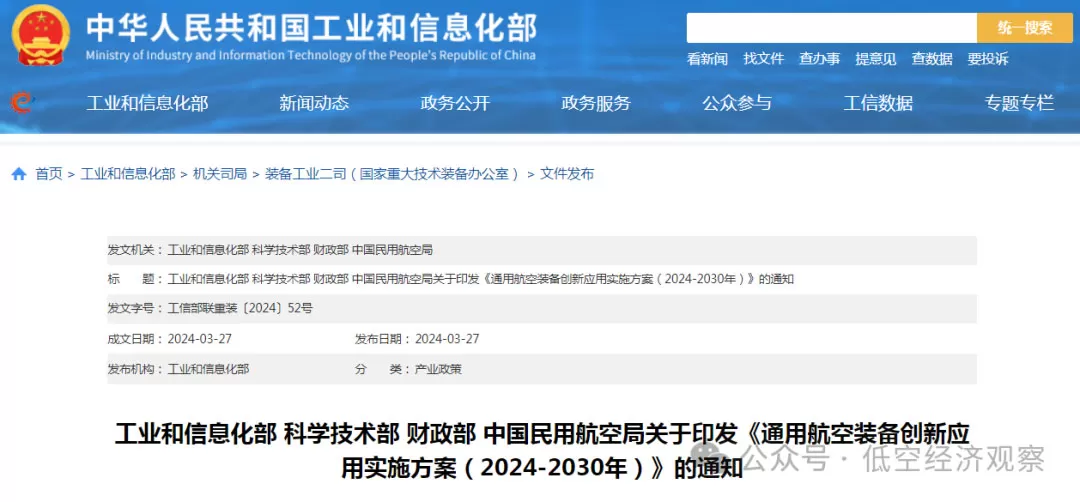
▪ Main objectives
By 2027.China's general aviation equipment supply capacity, industrial innovation capacity has been significantly improved, modernized general aviation basic support system is basically established, efficient integration of industrial ecology is initially formed, general aviation public service equipment system is basically perfect.New general aviation equipment featuring unmanned, electrified and intelligent technology has realized commercial applications in urban air transportation, logistics and distribution, emergency rescue and other fields.
--Innovation capacity has been significantly improved.The development and innovation of green, intelligent and new-configuration general aviation aircraft are at the advanced level in the world, and a number of industry-university-research joint laboratories, science and technology innovation centers and science and technology innovation service platforms in the field of general aviation have been formed. General aviation regulations and standards system and safety verification system are basically established.
--Demonstration applications are effective.Aviation emergency rescue, logistics and distribution to achieve large-scale application, urban air traffic to achieve commercial operation, the formation of more than 20 replicable and scalable typical application demonstrations, to create a number of low-altitude economic application demonstration bases, and the formation of a number of brand-name products.
-The level of modernization of the industrial chain has increased significantly.To create more than 10 ecologically dominant general aviation industry chain leading enterprises, to cultivate a number of speciality, speciality and new "small giants" and manufacturing industry single champion enterprises, general aviation power to achieve the development of the series, airborne, mission systems and ancillary equipment modularization, standardization of industrial supporting capacity has increased significantly.
By 2030.A new model for the development of the general aviation industry characterized by high-end, intelligent and green features has basically been established, supporting and guaranteeing the safe and efficient operation of the "short-haul transportation + electric vertical take-off and landing" passenger transportation network, the "trunk-support-terminal" unmanned aerial vehicle distribution network, and the low-altitude production and operation network that meets the needs of industrial and agricultural operations. The production and operation network will operate safely and efficiently.General aviation equipment is fully integrated into all areas of people's production and life, becoming a powerful driving force for low-altitude economic growth and forming a trillion-dollar market scale.
▪ Priority tasks
(i) Enhancement of industrial technology innovation capacity
1. Accelerate key core technology breakthroughs.Strengthen the key technologies in the fields of overall, system, software, components and materials. Aiming at the direction of unmanned and intelligentization, it will tackle core technologies such as precise positioning, perception and obstacle avoidance, autonomous flight and intelligent cluster operation. Taking electrification as the main direction of attack, taking into account hybrid, hydrogen, sustainable fuel power and other technical routes, accelerating breakthroughs in aviation electric propulsion technology and upgrading, and carrying out key technology research and development in high-efficiency energy storage, energy control and management, and emission reduction and noise reduction. It will strengthen the research on equipment safety technology, focus on breakthroughs in battery failure management, crash safety, data chain safety and other technologies, and enhance the ability to maintain airspace and the ability to be reliably monitored.
2. Improve the product spectrum of general aviation equipment.Accelerating the technical level of general aviation equipment and improving the reliability, economy and advancement of general aviation equipment. Promote large and medium-sized fixed-wing aircraft, plateau-type helicopters, as well as drones and other airworthiness certification and put them into operation, and realize the coverage of the whole region's emergency rescue capability. Support accelerating the development and production of regional logistics and terminal distribution drones and putting them into operation. Support the development of smart air travel (SAM) equipment, and promote the airworthiness certification of a number of new consumer general aviation equipment such as electric vertical take-off and landing aircraft (eVTOL). Encourage the research and development of flying car technology, product validation and exploration of commercial application scenarios. In response to the application needs of agricultural and forestry operations, industrial production, etc., continuously improve product competitiveness and market adaptability.
3. Build an industrial collaborative innovation platform.Focusing on technology research, innovation and application, safety management, etc., play the role of platforms such as the General Aviation Industry Innovation Alliance, and promote collaborative innovation among industries, universities, research institutes and applications. Strengthen the construction of regional general aviation science and technology innovation service platform. Facing new equipment, new technology and new fields, support the establishment of future air traffic equipment innovation research centers and build green intelligent safety technology innovation consortium. Focusing on seamless communication and surveillance, digital navigation, intelligent airspace management, etc., it will give full play to the role of the Low Altitude Intelligent Networking Technology Alliance and promote the layout of the low altitude intelligent networking system.
(ii) Enhancing the competitiveness of the industrial chain supply chain
4. Accelerate the series development of general aviation power products.Accelerate the development of 200kW-class, 1000kW-class turboshaft, 1000kW-class turboprop and other engines; continue to promote the mass delivery of 100-200 horsepower piston engines to realize market-scale application. Accelerate the layout of new energy general aviation power technology and equipment, promote the mass production of 400Wh/kg-class lithium aviation battery products, and realize the application verification of 500Wh/kg-class lithium aviation battery products; carry out the research and development of the hybrid propulsion system below 400kW; promote the large-scale mass production of aviation motors and drive systems of 250kW and below, as well as the application verification of 500kW-class products.
5. Promote the development of standardized modularization of airborne and mission systems and supporting equipment.In conjunction with the equipment needs in the fields of aviation emergency rescue, traditional operations, logistics and distribution, it has accelerated the promotion of unified standards and models, developed modularized and standardized mission systems, and enhanced the interchangeability and market compatibility of products. Continuously improve the spectrum of shelf-type general aviation supporting products to meet airworthiness requirements, accelerate the development of low-cost small avionics systems, and promote the coordinated development of supporting equipment and aircraft platforms.
6. Cultivate high-quality and diversified business entities.Encourage leading enterprises to integrate resources, strengthen the leadership and organizational synergy of the industrial chain, supply chain and innovation chain, continuously improve enterprise competitiveness, improve after-sales service guarantee capability, and enhance the resilience and safety level of the industrial chain. Support batteries, motors and other advantageous enterprises to increase R & D investment, improve product performance, and cultivate a number of well-known brand products. Guide general aviation equipment mission system, supporting enterprises to enhance competitiveness, to create a number of specialized, special new "small giants" and manufacturing industry single champion enterprises.
7. Building a number of advanced manufacturing clusters.Based on the development foundation and resource advantages, docking the national regional major strategies, in the Yangtze River Delta, Guangdong, Hong Kong and Macao, Chengdu-Chongqing, Jiangxi, Hunan, Shaanxi and other key areas, to build an integrated innovation and development industrial ecology from technology development, product development, demonstration and validation to the application and promotion, and to build a new advanced manufacturing cluster of general aviation equipment with the integration of large, medium-small, small and medium-sized enterprises, the agglomeration of innovation elements, and the high efficiency of the network coordination, so as to realize the deep integration of general aviation and the local economy. The deep integration of general aviation and local economy will be realized.
(iii) Deepening demonstration applications in key areas
8. Expand the demonstration application of aviation emergency rescue.Focusing on the four major areas of aviation fire-fighting, aviation rescue, public health services, and emergency communication/command, the demonstration and application of aviation emergency rescue equipment will be expanded in key areas such as Beijing-Tianjin-Hebei, the Yangtze River Delta, the Northeast, the central and western regions, and the border areas. Innovate the systematic application mode of aviation emergency rescue equipment, strengthen practical training, and promote the construction of a manned and unmanned, high and low collocation, reasonable layout, and functional complementary aviation emergency rescue equipment system. Accelerate the demonstration application of drones in the field of emergency rescue.
9. Deepen the demonstration application of air logistics and distribution.Focusing on the demand for logistics and distribution at the "trunk, branch and end" levels, in key areas such as the Yangtze River Delta, Guangdong, Hong Kong and Macao, Sichuan, Chongqing, Inner Mongolia, Shaanxi and Xinjiang, it is encouraged to carry out demonstrations of inter-city transportation and end-of-pipe distribution applications of unmanned aerial vehicles, so as to form a large-scale system of aviation logistics and distribution equipment. It will support research into low-altitude logistics solutions, explore new modes of intelligent logistics, promote large-scale drone feeder logistics networks, as well as the large-scale application of drone distribution in emerging scenarios such as cities, villages, mountainous areas and islands, and promote the construction of an aviation logistics and distribution network.
10. Accelerate the demonstration and application of urban air transportation.Adapting to the future needs of urban air transportation, support the application demonstration focusing on eVTOL in key regions such as the Yangtze River Delta, Guangdong, Hong Kong and Macao, and support the organization of related events. It supports a number of SAM equipment to accelerate market application, encourages the exploration of the construction of a low-altitude route network for three-dimensional transportation, and focuses on fostering new modes of manned air transportation such as business trips, aerial ferries, and private charter flights.
11. Expanding new general aviation consumer demonstration applications.For the consumer markets of low-altitude tourism, air sports, private flights and business aviation, "general aviation +" application demonstrations have been carried out in key areas such as Shanxi, Inner Mongolia, Shanghai, Henan, Hunan, Hainan and Xinjiang. Encourage conditional areas to develop diversified low-altitude tourism products, and promote the application of "general aviation + tourism" demonstration. Supporting the development of flight experience, skydiving and other consumer flight activities, vigorously promoting light sport aircraft and aerobatic vehicles, and promoting the application demonstration of "general aviation + sports".
12. Promote traditional general aviation operations at scale.Encourage traditional general aviation business areas such as aviation training, short-haul transportation, agriculture, forestry and plant protection, and physical exploration and inspection, and carry out demonstrations of large-scale and normalized operation in key areas such as Sichuan and Chongqing, Inner Mongolia, Heilongjiang and Xinjiang. Promote the batch delivery and operation of general aviation equipment for short-haul passenger transportation. Encourage the broadening of the commercial application of UAVs in such scenarios as electric power patrol, ecological monitoring, aerial photography and aerial surveying, and aerial physical exploration.
(iv) Promoting the construction of a basic support system
13. Promote the construction of an intelligent and efficient new operational service system.Accelerate the integration of 5G, satellite Internet and other applications, and support the exploration of low-altitude intelligent networking technologies and standards for the interconnection of air and space facilities and the sharing of information. Promote the standardized application of Beidou for general aviation aircraft. Promote synergy between governments and enterprises in pilot areas in low-altitude regulatory service infrastructure, network planning and construction, and promote the opening up of public information such as three-dimensional high-precision maps, meteorological data and communication and navigation. Promote the construction of visual route networks, support the improvement of operation rules, improve the protection mechanism of aeronautical information data, and enhance the flight service protection capability. Encourage enterprises to build flight service systems integrating intelligent dispatching, dynamic monitoring and real-time intelligence services.
14. Promote the construction of a new infrastructure support facilities system.Encourage local governments to incorporate low-altitude infrastructure into urban construction planning and to strengthen connections with urban transportation systems. It supports the exploration and promotion of pilot construction of scenario take-off and landing points on rooftops, on the ground and on water, and the improvement of functional services such as navigation and positioning, communications, meteorology and charging, so as to form a multi-scenario, multi-principal and multi-level network of take-off and landing points. Make full use of the existing aviation infrastructure and promote the construction of a number of intelligent, integrated and multi-purpose general aviation infrastructure. Encourage new residential and commercial buildings to reserve low altitude infrastructure. Fully integrating the characteristics of the development of the general aviation industry, research has been conducted to set airport construction standards applicable to the development of the general aviation industry.
15. Improve the system of regulations and standards.Adhere to the integration of general aviation standardization with technological innovation and application demonstration, and realize the synergistic development of national standards, industry standards and group standards. Encourage leading enterprises to drive upstream and downstream enterprises to jointly carry out standards research, and accelerate the establishment of a standards system covering a variety of application scenarios and various types of equipment. Strengthen collaboration between industrial parties and airworthiness validators, and coordinate and promote the convergence of industrial standards and airworthiness systems. Coordinate and promote the improvement of the national aircraft management system, and clarify the regulatory requirements for application scenarios.
16. Establishment of a security verification system.Make full use of the existing aviation industrial base, accelerate the sharing of testing and verification resources, encourage the establishment of general aviation airworthiness technical services and compliance verification, third-party testing and experimentation capabilities for UAVs, and support the construction of bases for flight testing and application testing. Build a quality assurance and safety verification system for UAVs, strengthen the safety and reliability assessment and verification of industrial-grade UAVs and eVTOL, and promote the formation of a number of industrial standards to support airworthiness validation.
17. Strengthen the foundation of the talent team.Support colleges and universities to strengthen the construction of general aviation-related disciplines and specialties, and build a number of specialty colleges. Focusing on the cutting-edge emerging cross-cutting fields of general aviation, deepen the integration of industry and education, and promote the joint and precise talent training of universities, research institutions and enterprises. Carry out the training of eVTOL pilots, manipulators and other professionals, and promote the formation of norms in the areas of consistent driving and manipulation of emerging aviation equipment and technical training of pilots. Encourage localities to introduce talent support policies for the general aviation industry.
(v) Building an efficient and integrated industrial ecosystem
18. Promote the efficient integration of general aviation equipment manufacturing and the service industry.In emerging application fields such as unmanned logistics and urban air transportation, leading enterprises are encouraged to explore the formation of business models integrating product development, scene construction and demonstration operation. In the field of aviation emergency rescue, general aviation operating enterprises with rich experience, strong strength and outstanding safeguard capability are encouraged to collaborate efficiently with equipment manufacturing enterprises to develop specialized aviation emergency rescue equipment operating platforms.
19. Deepen domestic and international exchanges and cooperation on general aviation equipment.Relying on intergovernmental cooperation mechanisms, promote domestic and international exchanges and cooperation in such fields as electric aircraft. Encourage general aviation enterprises to carry out R&D and design, flight verification and airworthiness certification overseas, and actively explore the international market. It will strengthen docking and exchanges with international organizations, promote bilateral and multilateral cooperation, and support domestic enterprises to participate in the formulation of international rules and the revision of standards in the fields of unmanned aircraft and electric aircraft.
20. Explore the new mode of scientific and technological financial cooperation in the general aviation equipment industry.Giving full play to the policy advantages of science and technology innovation refinancing, financial institutions are encouraged to increase their support for general aviation manufacturing enterprises that meet the policy requirements. Implement the special project of "Science and Technology Industry Financial Integration", give full play to the role of the national industry-integrated cooperation platform, make full use of venture capital and other financial means, and strengthen the financing support for the technology research and development of the general aviation equipment industry. Promote the formation of diversified equity general aviation equipment leasing company, encourage insurance companies for general aviation equipment "research, production, marketing and use" of the whole industrial chain of innovative products and services. Encourage conditional areas to accurately guide technology, capital, talent and other types of factors and resources to general aviation manufacturing enterprises to effectively gather.
▪ Organizational security
(i) Strengthening integration and linkages.Strengthen departmental coordination, reinforce central and local linkage, and orderly promote the construction of general aviation industry and resource guarantee efforts. Give full play to local advantages, combine local basic conditions and potential needs, and actively explore in the application demonstration of general aviation equipment, industrial cluster construction, industrial ecological cultivation and industrial policy formulation. The General Aviation Industry Innovation and Development Expert Committee will be formed to strengthen strategic research, decision-making support and consulting services for the development of the general aviation industry.
(ii) Increased policy support.Give full play to the role of the first (set) of major technical equipment insurance compensation policy to support the popularization and application of general aviation equipment. Give full play to the role of government procurement and increase the procurement of general aviation equipment and services. Implement the State Council's requirements on investment approval of aviation projects and standardize the investment approval procedures for general aviation projects. According to the needs, study the expansion of the supply and standardized use of radio frequencies for drones in urban air traffic and other application areas.
(iii) Creating a favorable atmosphere.Give full play to the role of industry organizations, strengthen cooperation and exchanges at home and abroad, inside and outside the industry, promote the development of upstream and downstream industry chain docking, strengthen the regulations and standards publicity, and strengthen industry self-discipline. Guide all parties to standardize high-level general aviation exhibitions, forums and events, and regularly organize and hold supply and demand docking meetings. Develop aviation popularization education, and vigorously cultivate the consumer culture of general aviation.
Below is an illustration of the Implementation Program
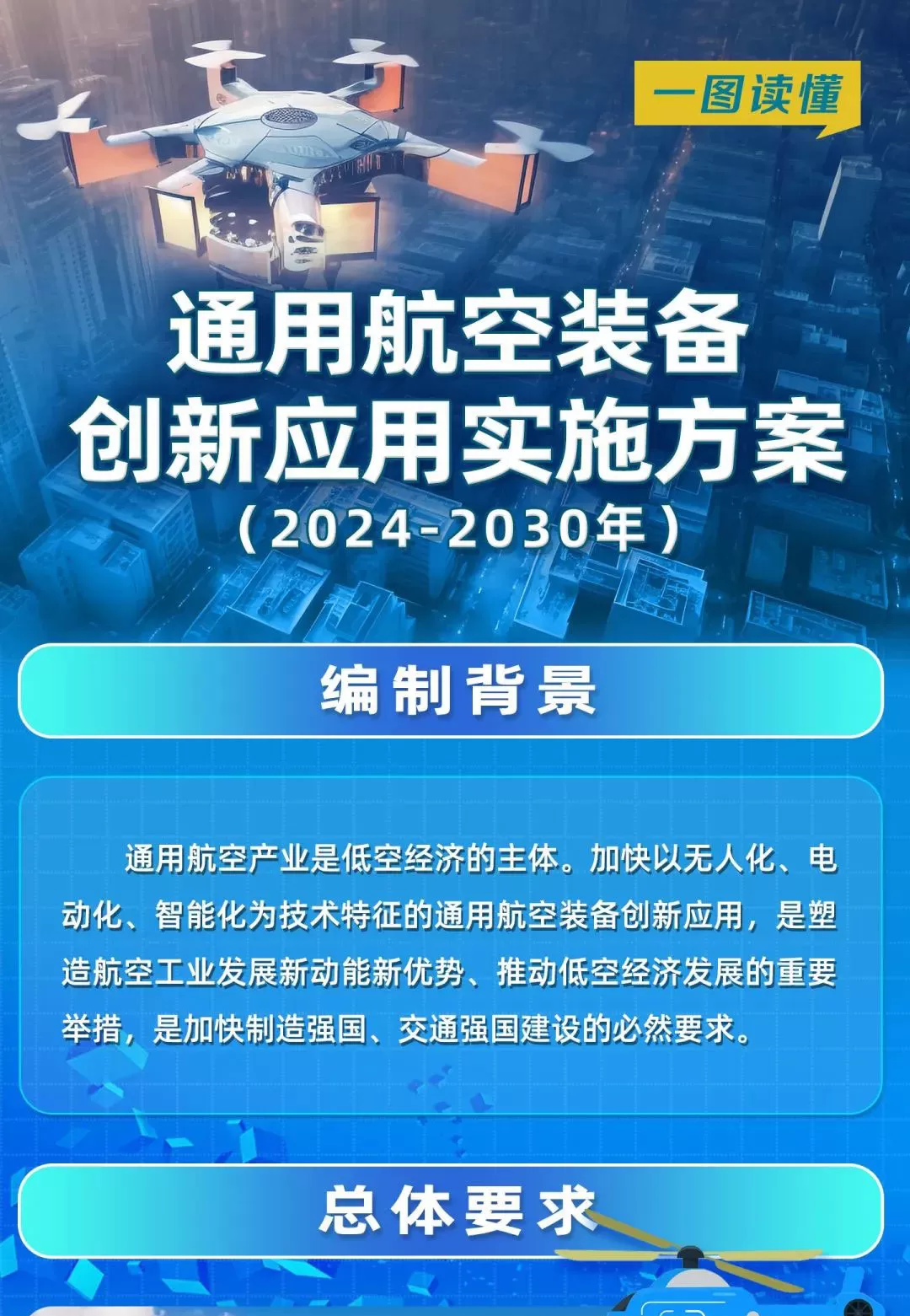
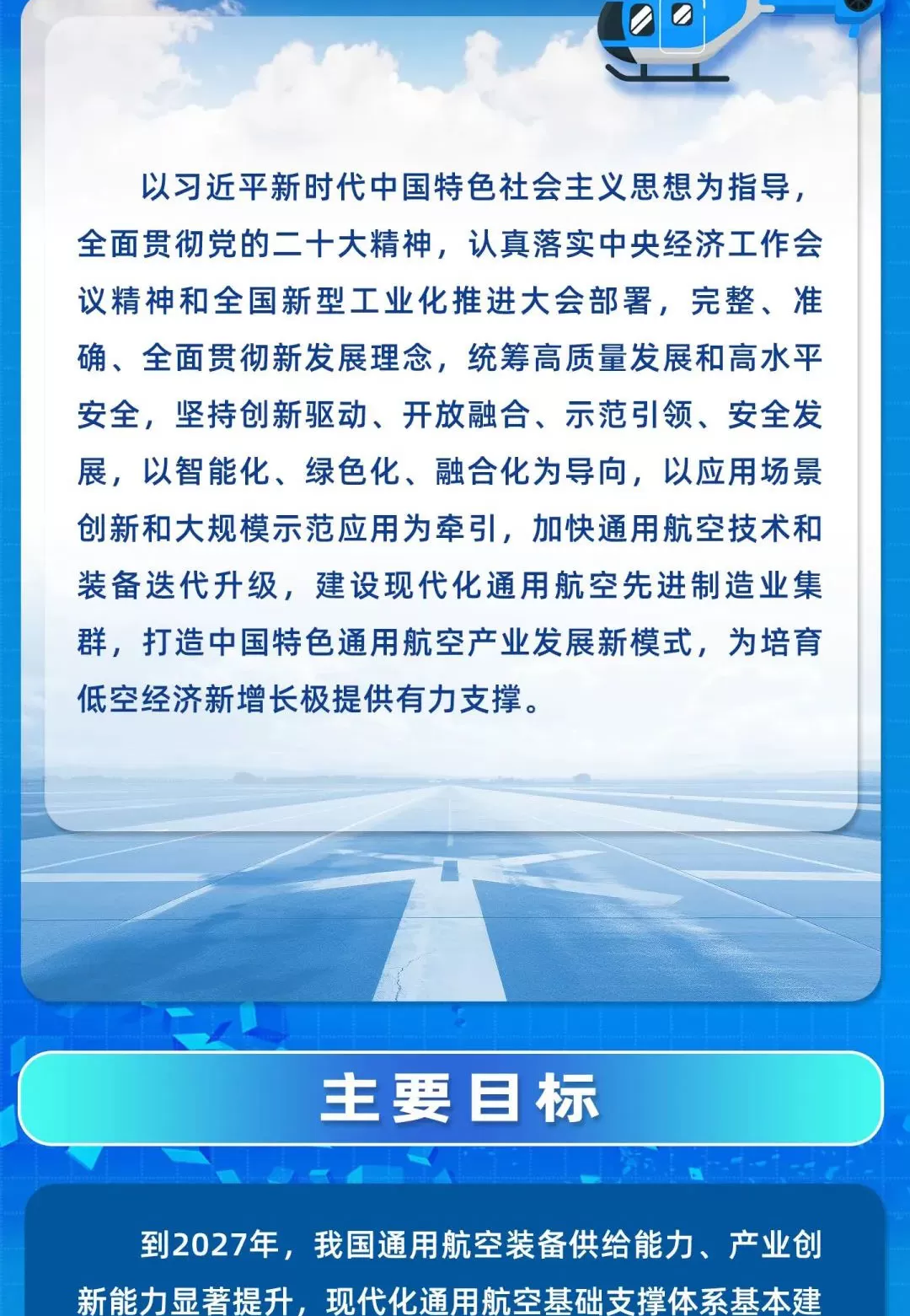
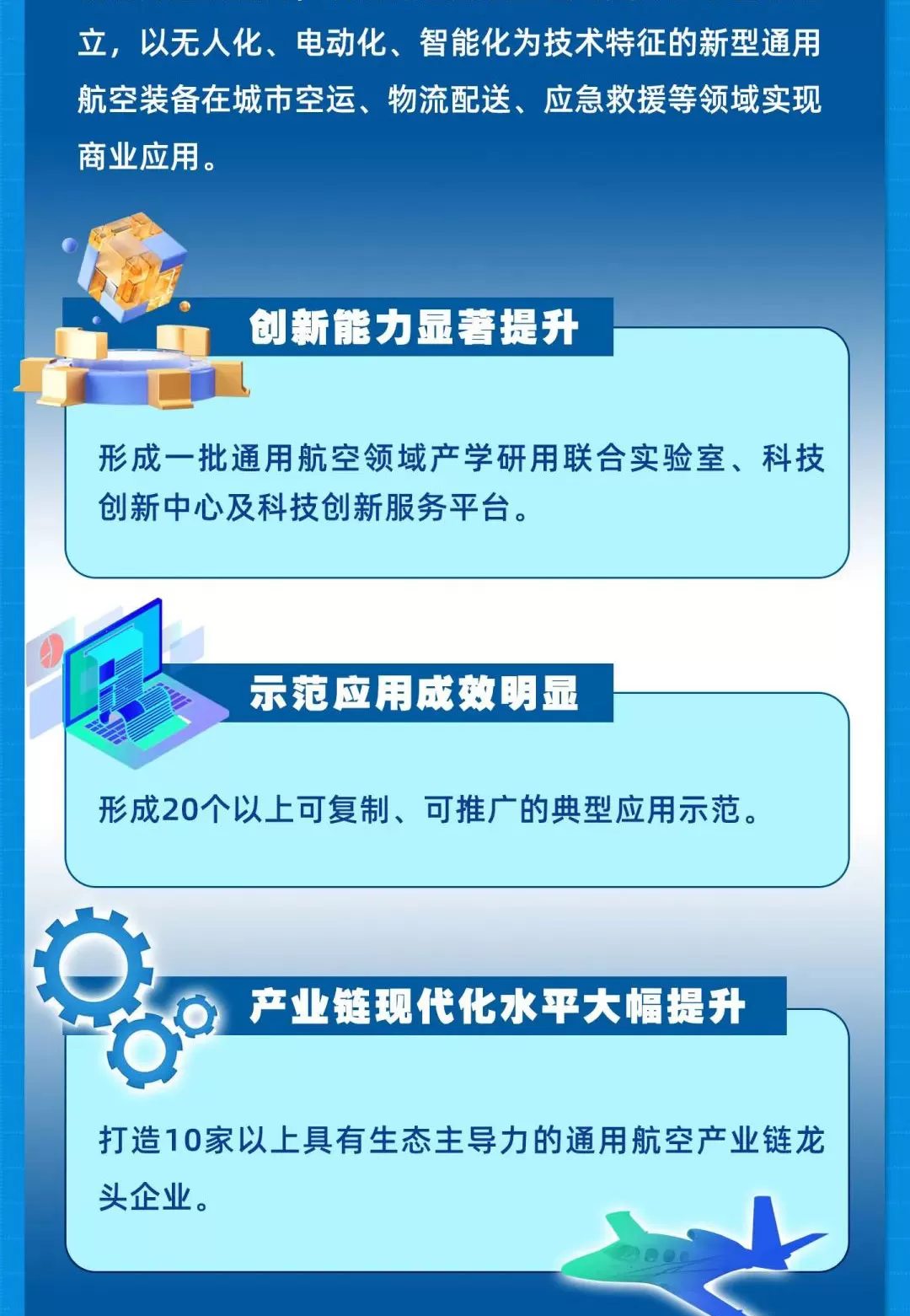
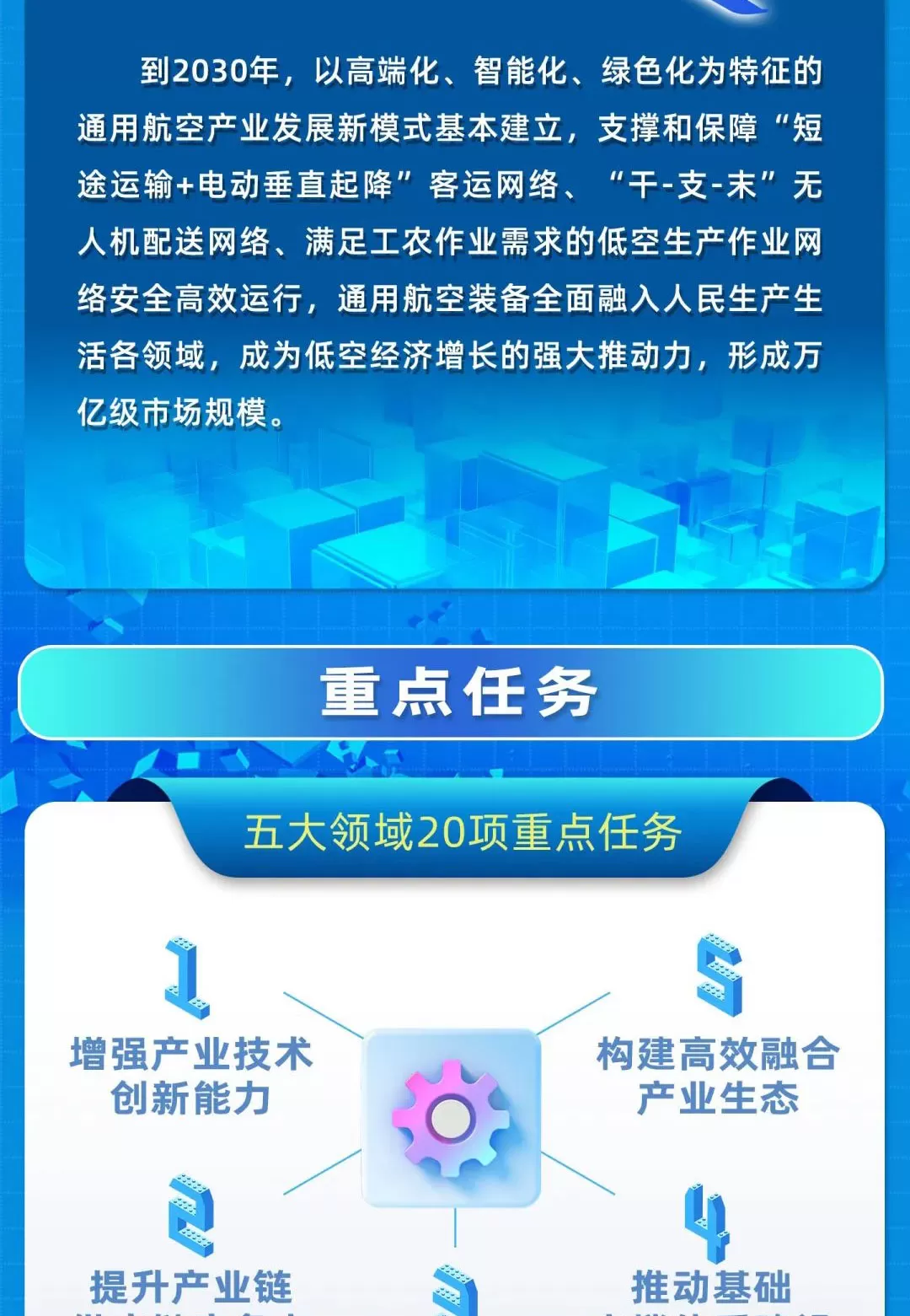
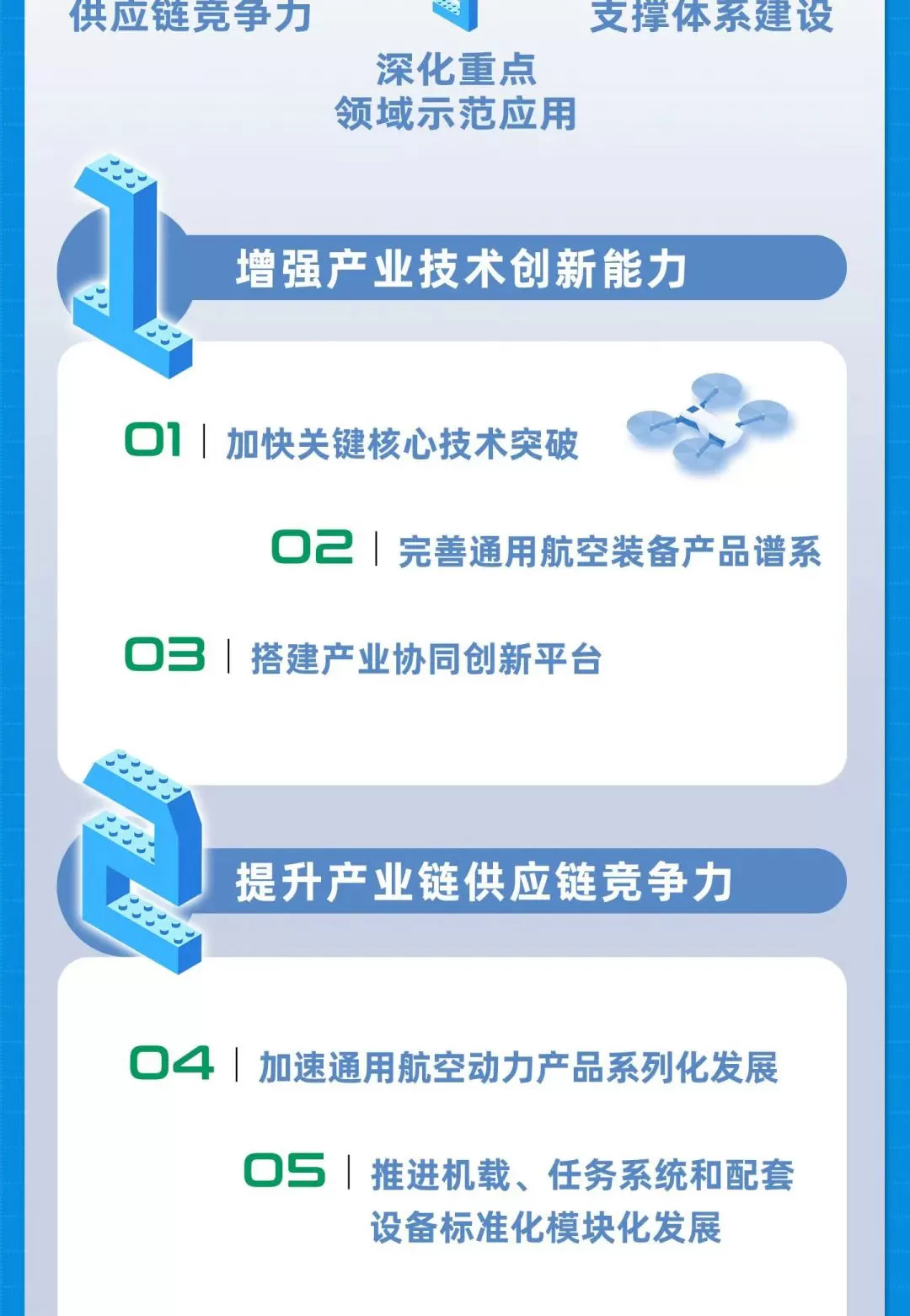
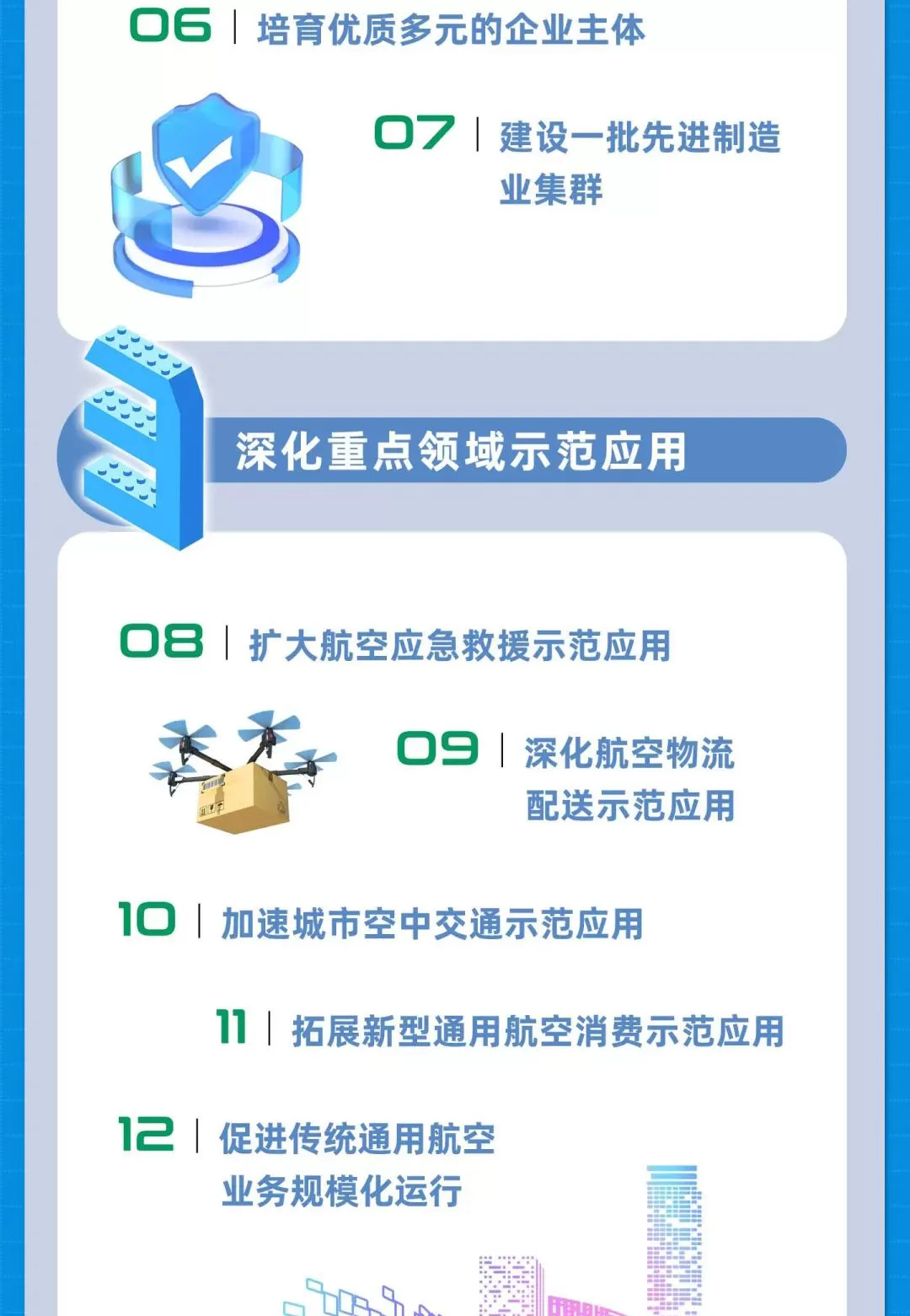
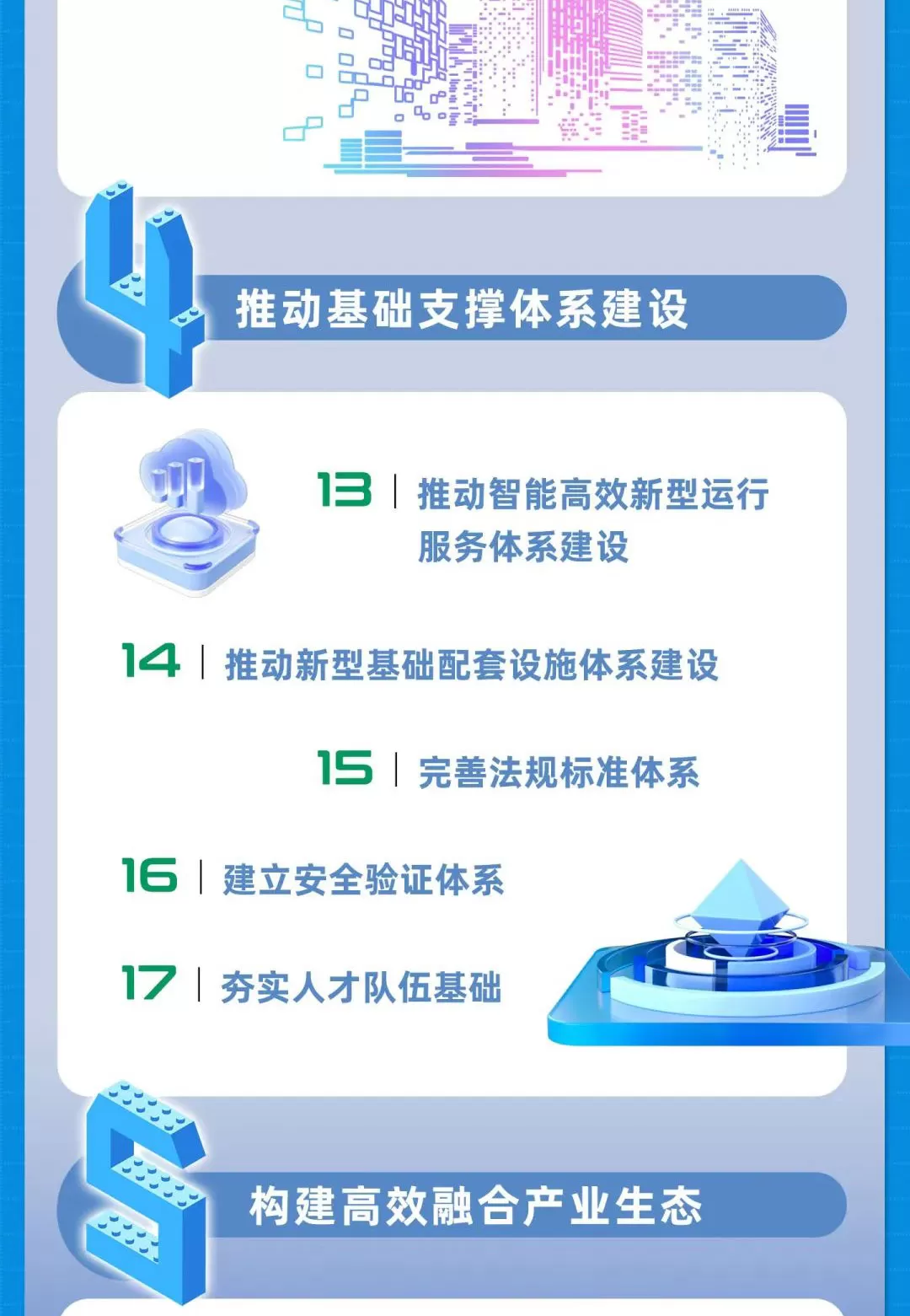
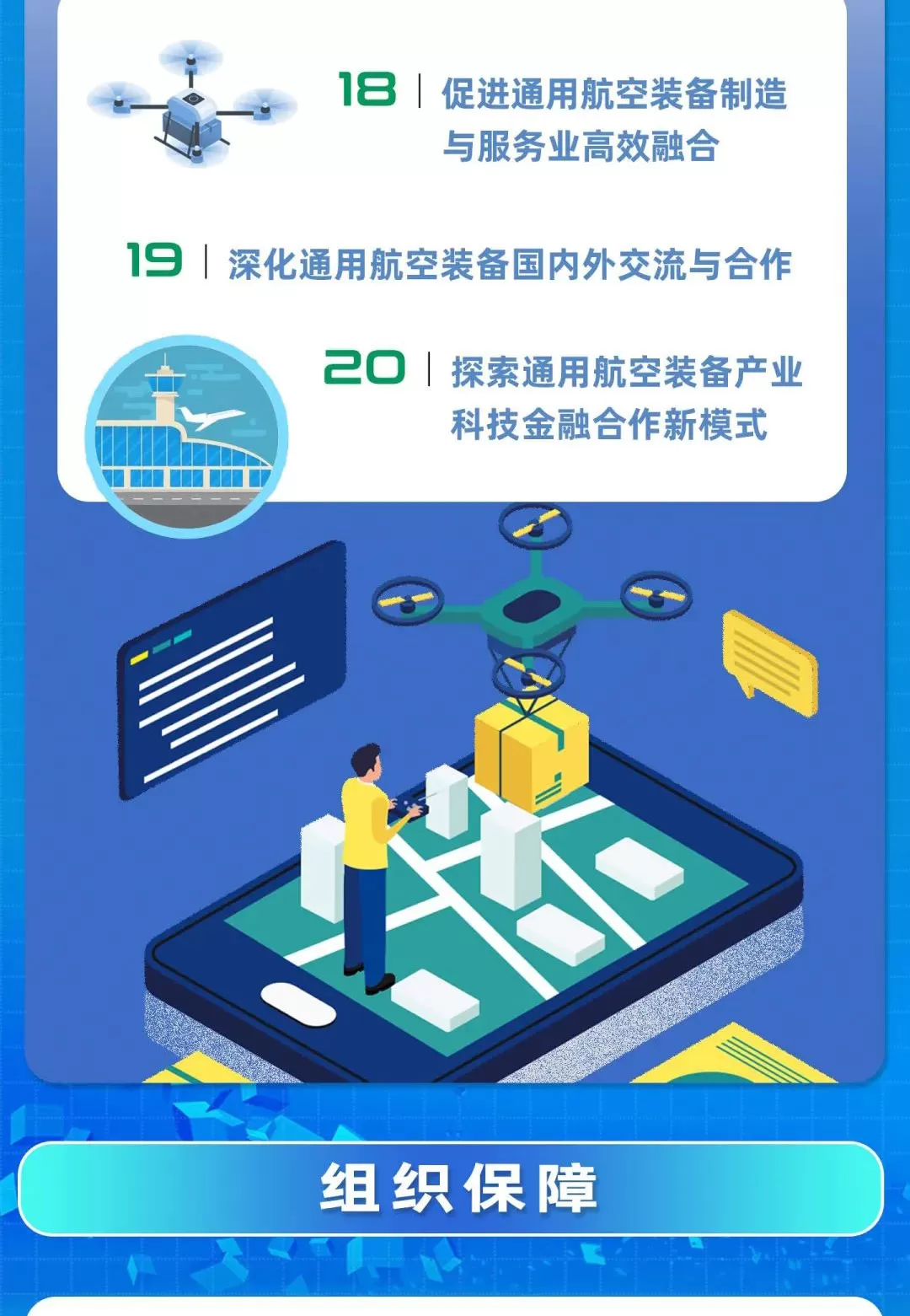
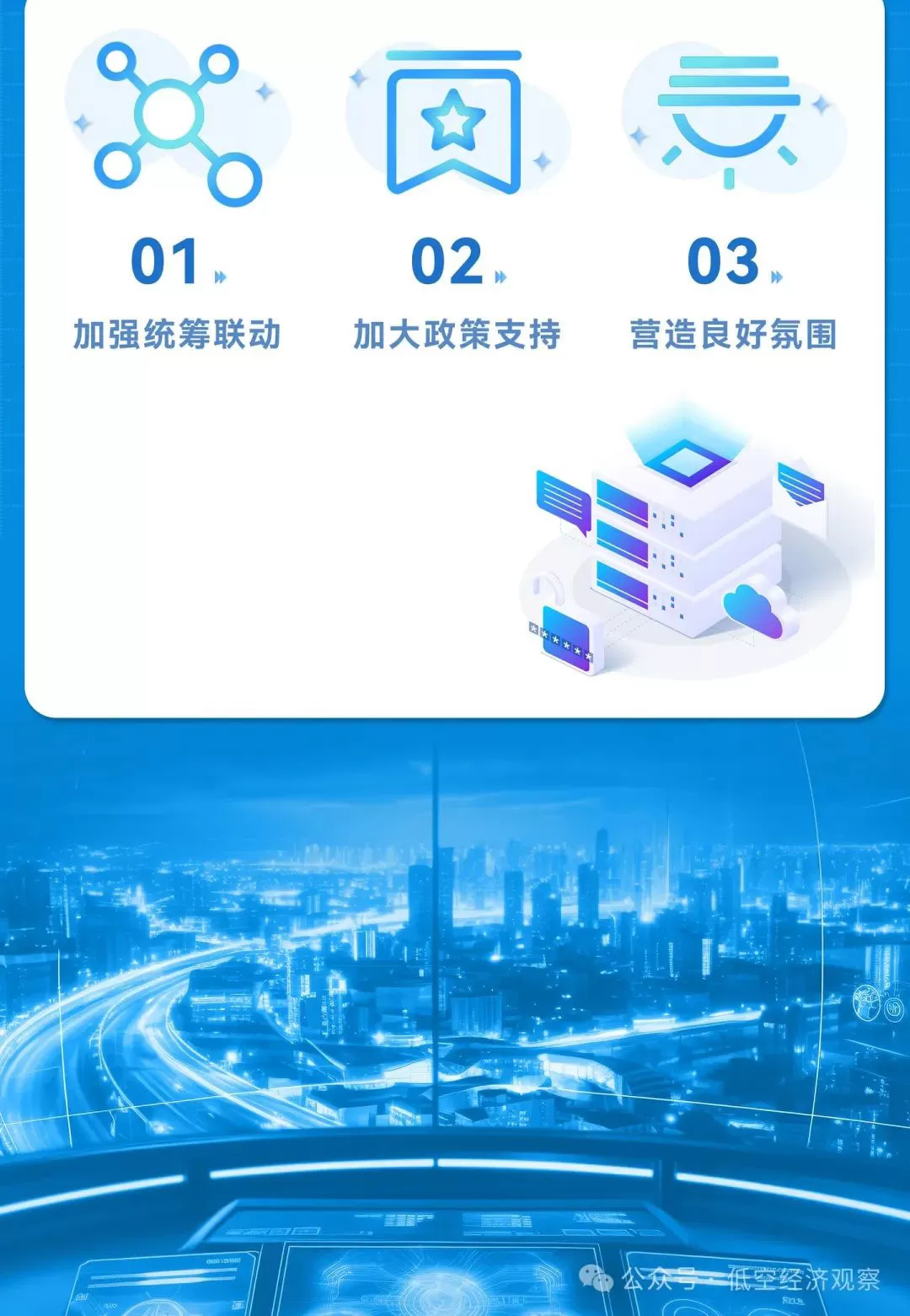
Source: Ministry of Industry and Information Technology website, edited by Low Altitude Economy Watch.

